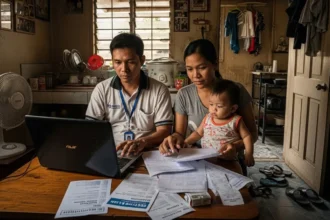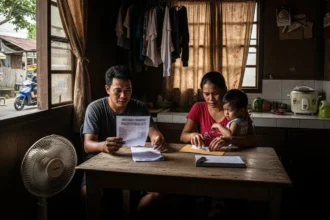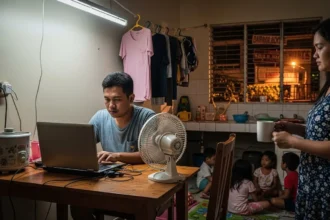Saving ₱100,000 in just one year might sound impossible, especially when salaries in the Philippines are stretched thin by food, bills, and daily expenses. But here’s the thing: countless Filipinos have already done it – not because they’re earning huge salaries, but because they followed a clear system. That system is what many call the Pinoy Ipon Challenge, a set of saving hacks and strategies designed to make the dream of six-digit savings a reality.
- 📊 Understanding the ₱100K Ipon Challenge
- 📝 Step-by-Step Savings Plan
- 📦 Table 1: Sample ₱100K Ipon Challenge Breakdown
- 🏠 Budgeting Basics for Pinoys
- 📊 Table 2: Common Pinoy Expenses and How to Adjust
- 🧠 Mindset Hacks to Stay Motivated
- 🌐 The Role of Digital Banking in the Ipon Challenge
- 🛡 Pros and Cons of the Ipon Challenge
- ❓ Frequently Asked Questions (FAQ)
- ✨ Final Reflection: Turning the Ipon Challenge into a Lifestyle
- 💸 References
The concept of saving often feels like a luxury. With rising grocery prices, rent, school expenses, and emergency needs, many workers feel like they’re living paycheck-to-paycheck. The idea of pulling together ₱100,000 can feel like a far-off fantasy. But the truth is, it’s about discipline and mindset, not just income size. Filipinos earning minimum wage have shown that with structured planning, consistent saving, and creative hacks, they too can reach this goal.
In fact, the Ipon Challenge became viral on social media a few years ago because ordinary Pinoys began sharing photos of their envelopes, jars, and bank accounts filled with savings. It was proof that saving wasn’t just for the rich – it was for anyone willing to commit to the habit. And in 2025, as inflation continues to test everyone’s budget, this challenge is more relevant than ever.
This article will guide you step by step on how to complete the ₱100K Ipon Challenge in 12 months. We’ll explore different saving strategies, budgeting tricks, motivational hacks, and the common mistakes that stop people from succeeding. By the end, you’ll see that saving ₱100,000 isn’t just possible – it’s practical.
📊 Understanding the ₱100K Ipon Challenge
The idea behind the Ipon Challenge is simple: break down a big number into smaller, manageable amounts. Saving ₱100,000 in one year means putting away about ₱8,333 per month or roughly ₱278 per day.
This breakdown shows the goal isn’t as intimidating as it looks. Instead of focusing on the full ₱100K, you focus on the small amounts you can regularly set aside. Whether you choose daily, weekly, or monthly saving schedules, consistency is the most important factor.
Filipinos love the envelope system, coin jars, and digital banking apps for tracking progress. The key is making it visual and rewarding, so you can see your progress pile up little by little.
📝 Step-by-Step Savings Plan
Breaking down the ₱100K goal into clear steps makes it easier to follow:
- Daily Saving: ₱278 per day → ₱100,000 in 12 months.
- Weekly Saving: ₱1,923 per week → ₱100,000 in 12 months.
- Monthly Saving: ₱8,333 per month → ₱100,000 in 12 months.
This system works for both regular employees and freelancers. If your income is irregular, choose the weekly or monthly system and save larger amounts when you earn extra.
📦 Table 1: Sample ₱100K Ipon Challenge Breakdown
| Method | Amount to Save | Time Frame | Notes |
|---|---|---|---|
| Daily | ₱278 | 365 days | Great for disciplined daily earners |
| Weekly | ₱1,923 | 52 weeks | Works well for weekly wage earners |
| Monthly | ₱8,333 | 12 months | Best for salaried employees |
🏠 Budgeting Basics for Pinoys
Before starting the challenge, you need to check where your money is going. Many Pinoys underestimate how much daily expenses like milk tea, Grab rides, or online shopping add up. Tracking your spending for one month can reveal areas where you can cut back.
- Cancel unused subscriptions (like streaming services you rarely use).
- Limit “wants” like takeout and impulse buys.
- Use cash for groceries to avoid overspending.
- Cook at home more often.
Small adjustments like these can free up thousands each month, enough to hit your Ipon Challenge targets.
📊 Table 2: Common Pinoy Expenses and How to Adjust
| Expense Category | Average Monthly Cost | Savings Hack |
|---|---|---|
| Milk tea & coffee | ₱1,500 | Make coffee at home |
| Grab/Taxi | ₱2,000 | Use jeepneys/trains more often |
| Online shopping | ₱3,000 | Impose a “24-hour rule” before checkout |
| Dining out | ₱2,500 | Cook meals at home |
🧠 Mindset Hacks to Stay Motivated
The biggest enemy of saving is not poverty – it’s temptation and lack of consistency. Motivation often fades after the first few months. That’s why Pinoys who succeed in the challenge often apply psychological hacks.
- Use a savings tracker on your wall or phone.
- Tell family or friends so they can hold you accountable.
- Reward yourself with small treats at milestones (₱25K, ₱50K, ₱75K).
- Follow online “Ipon Challenge” communities for motivation.
These little strategies create a sense of progress and keep you emotionally invested.
🌐 The Role of Digital Banking in the Ipon Challenge
Digital banks like GCash, Maya, Tonik, and Seabank are changing the way Filipinos save. Many of them offer higher interest rates than traditional banks, plus the ability to lock savings so you can’t withdraw easily.
These apps also allow you to set automated transfers, which is perfect for the Ipon Challenge. Instead of manually saving ₱8,333 every month, you can schedule an automatic deduction right after payday. This removes the temptation to spend it.
🛡 Pros and Cons of the Ipon Challenge
Pros ✅
- Easy to follow with clear steps.
- Builds discipline and long-term money habits.
- Helps Pinoys build emergency funds.
- Can be done by almost any income level.
Cons ❌
- Requires strict discipline.
- Unexpected emergencies can interrupt saving.
- Not ideal for those with high debts unless managed properly.
❓ Frequently Asked Questions (FAQ)
Q1: Is it really possible to save ₱100K in one year in the Philippines?
Yes. Many Filipinos have done it. The key is breaking the amount into smaller, consistent savings and sticking to a strict budget. Even minimum wage earners have completed the challenge with discipline and side hustles.
Q2: Should I prioritize paying debt or starting the Ipon Challenge?
It depends on your debt. If the interest is very high (credit cards), pay that first. But you can still save small amounts while paying debt, so you don’t completely delay your savings habit.
Q3: What’s the best method – daily, weekly, or monthly?
Choose the one that matches your income schedule. Salaried employees do best with monthly saving, while freelancers may prefer weekly. The daily method is strict but effective for those with strong discipline.
Q4: Where should I keep my savings?
Digital banks with higher interest rates and lock-in features are ideal. Some people also use physical cash envelopes, but they carry risks of theft or misuse.
Q5: What if I miss a week or month?
Don’t quit. Just adjust your plan by saving more the next payday. Missing a target is common, but persistence is what makes the challenge successful.
Q6: Can students or unemployed people do the challenge?
Yes, but on a smaller scale. Instead of ₱100K, try ₱10K or ₱20K. The habit of saving regularly is more important than the exact number.
Q7: Should I tell my family I’m doing the Ipon Challenge?
Yes, especially if you live with them. Family support can help reduce pressure to spend and even encourage them to join you.
Q8: How do I avoid using the money before the year ends?
Keep your savings in a lock-in account, or store cash in sealed containers you can’t open easily. The harder it is to access, the safer it will be.
Q9: Is it better to save in peso bills or coins?
Both work. Some Filipinos save ₱50 bills, others save coins. What matters is consistency, not the form.
Q10: What’s the next step after completing the challenge?
Use the ₱100K wisely – as an emergency fund, investment seed money, or to pay down debt. The goal is not just saving, but building financial freedom.
✨ Final Reflection: Turning the Ipon Challenge into a Lifestyle
The ₱100K Ipon Challenge is more than just a social media trend – it’s a movement that proves Filipinos can take control of their finances even in the toughest times. What starts as a simple challenge often becomes a lifelong habit, showing people that financial security isn’t about how much you earn, but how wisely you manage what you have.
By following this challenge, you train yourself to delay gratification, resist unnecessary spending, and stay committed to long-term goals. More importantly, you prove to yourself that discipline is possible, and that every small peso counts.
But here’s the most powerful part: the Ipon Challenge doesn’t end when you reach ₱100K. It’s the beginning of a financial journey. With the same habits, you can save for bigger goals – ₱500K, ₱1M, or even early retirement. The principle remains the same: start small, stay consistent, and keep pushing.
Filipinos have always been known for resilience. The Ipon Challenge is simply another reflection of that spirit – turning hardship into discipline, and discipline into success. The question is no longer can you do it? The real question is: will you commit to it today?
💸 References
-
Digido PH – The Best Ipon Challenges in 2025
-
Tonik Bank – Ipon Challenge Ideas to Try in 2025
-
Maya PH – Take on the “Ipon” Challenge: 5 Fun and Effective Ways to Save
-
Home Credit PH – Best Ipon Challenge Ideas to Save More this 2025
-
Facebook “Pinoy Ipon Challenge” Group – Pinoy Ipon Challenge Community
-
YouTube – 5 Ipon Hacks para Makaipon ng 100K sa Loob ng Isang Taon










